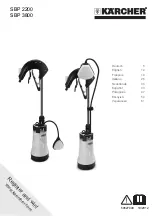
95
SERVICING
EXAMPLE:
A. Suction Pressure = 143
B. Corresponding Temp. °F. = 50
C. Thermometer on Suction Line = 61°F.
To obtain the degrees temperature of superheat, subtract 50.0
from 61.0°F.
The difference is 11° Superheat. The 11° Superheat would fall in
the ± range of allowable superheat.
S-109 CHECKING SUBCOOLING
Refrigerant liquid is considered subcooled when its temperature
is lower than the saturation temperature corresponding to
its pressure. The degree of subcooling equals the degrees of
temperature decrease below the saturation temperature at the
existing pressure.
1. Attach an accurate thermometer or preferably a
thermocouple type temperature tester to the liquid line as
it leaves the condensing unit.
2. Install a high side pressure gauge on the high side (liquid)
service valve at the front of the unit.
3. Record the gauge pressure and the temperature of the
line.
4. Review the technical information manual or specification
sheet for the model being serviced to obtain the design
subcooling.
5. Compare the hi-pressure reading to the “Required Liquid
Line Temperature” chart (page 108). Find the hi-pressure
value on the left column. Follow that line right to the
column under the design subcooling value. Where the two
intersect is the required liquid line temperature.
Alternately you can convert the liquid line pressure gauge
reading to temperature by finding the gauge reading in
Temperature - Pressure Chart and reading to the left, find
the temperature in the °F. Column.
6. The difference between the thermometer reading and
pressure to temperature conversion is the amount of
subcooling.
Add charge to raise subcooling. Recover charge to lower
subcooling.
Subcooling Formula = Sat. Liquid Temp. - Liquid Line Temp.
EXAMPLE:
A. Liquid Line Pressure = 417
B. Corresponding Temp. °F. = 120°
C. Thermometer on Liquid line = 109°F.
To obtain the amount of subcooling subtract 109°F from 120°F.
The difference is 11° subcooling. See the specification sheet or
technical information manual for the design subcooling range for
your unit.
S-110 CHECKING EXPANSION VALVE OPERATION
1. Remove the remote bulb of the expansion valve from the
suction line.
2. Start the system and cool the bulb in a container of ice
water, closing the valve. As you cool the bulb, the suction
pressure should fall and the suction temperature will rise.
3. Next warm the bulb in your hand. As you warm the
bulb, the suction pressure should rise and the suction
temperature will fall.
4. If a temperature or pressure change is noticed, the
expansion valve is operating. If no change is noticed, the
valve is restricted, the power element is faulty, or the
equalizer tube is plugged.
5. Capture the charge, replace the valve and drier, evacuate
and recharge.
S-112 CHECKING RESTRICTED LIQUID LINE
When the system is operating, the liquid line is warm to the
touch. If the liquid line is restricted, a definite temperature
drop will be noticed at the point of restriction. In severe cases,
frost will form at the restriction and extend down the line in the
direction of the flow.
Discharge and suction pressures will be low, giving the
appearance of an undercharged unit. However, the unit will have
normal to high subcooling.
Locate the restriction, replace the restricted part, replace drier,
evacuate and recharge.
S-113 OVERCHARGE OF REFRIGERANT
An overcharge of refrigerant is normally indicated by an
excessively high head pressure.
An evaporator coil, using an expansion valve metering device,
will basically modulate and control a flooded evaporator and
prevent liquid return to the compressor.
An evaporator coil, using a capillary tube metering device, could
allow refrigerant to return to the compressor under extreme
overcharge conditions. Also with a capillary tube metering
device, extreme cases of insufficient indoor air can cause icing of
the indoor coil and liquid return to the compressor, but the head
pressure would be lower.
There are other causes for high head pressure which may be
found in the “Service Problem Analysis Guide”.
If other causes check out normal, an overcharge or a system
containing non-condensables would be indicated.
















































